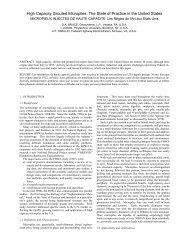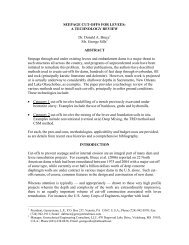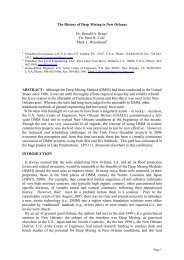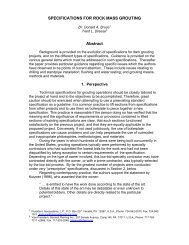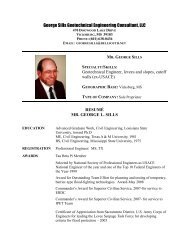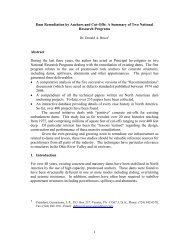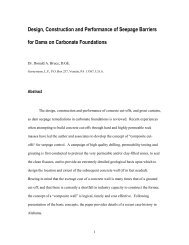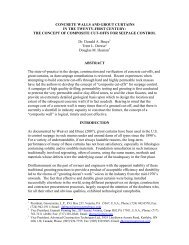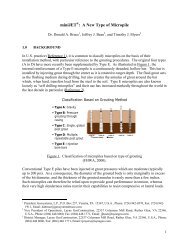high capacity and fully removable soil anchors - Geosystems, L.P.
high capacity and fully removable soil anchors - Geosystems, L.P.
high capacity and fully removable soil anchors - Geosystems, L.P.
Create successful ePaper yourself
Turn your PDF publications into a flip-book with our unique Google optimized e-Paper software.
These developments have resulted in an<br />
increase in working <strong>capacity</strong> for normal<br />
<strong>anchors</strong> from the 25 to 60 tonnes typically<br />
available in the 1960s (Littlejohn, 1970), to the<br />
50 to 100 tonnes now typically obtainable.<br />
Inefficiency of load transfer in conventional<br />
<strong>anchors</strong> is due in part to non-uniform load<br />
distribution along the bond length. It is <strong>fully</strong><br />
acknowledged by researchers who have<br />
investigated grout/ground load transfer that the<br />
distribution of stress along the fixed anchor is<br />
non-uniform due to general incompatibility<br />
between elastic moduli of the anchor tendon,<br />
anchor grout, <strong>and</strong> the ground (Ostermayer,<br />
1975; Littlejohn <strong>and</strong> Bruce, 1977; Fujita et al.,<br />
1978; Shields et al., 1987; Casanovas, 1989;<br />
Ludwig <strong>and</strong> Weatherby, 1989; Mecsi, 1995<br />
<strong>and</strong> 1997; Briaud et al., 1998). In the vast<br />
majority of conventional <strong>anchors</strong>, after initial<br />
loading, the bond stress is concentrated over<br />
the proximal end of the fixed anchor, while the<br />
distal end of the fixed length remains<br />
unstressed. As load is increased, the ultimate<br />
bond stress at the proximal end of the fixed<br />
length along either (or both) the steel/grout<br />
interface or the grout/ground interface is<br />
exceeded. At that moment, the bond stress<br />
reduces to a residual value at that location, the<br />
<strong>capacity</strong> at that location of the anchor is<br />
reached, <strong>and</strong> movement occurs.<br />
Subsequently, the <strong>capacity</strong> in that section of<br />
the anchor decreases, <strong>and</strong> the load is<br />
transferred towards the distal end of the fixed<br />
length. As load on the anchor is further<br />
increased, the bond stress concentration zone<br />
progresses further along the fixed anchor.<br />
Just prior to pull-out, the load is concentrated<br />
at the distal end of the fixed length. Figure 1a<br />
depicts this load transfer phenomenon,<br />
referred to as “progressive debonding.” The<br />
area under the bond stress distribution line<br />
represents the ultimate load in the anchor. It<br />
can be seen that the load does not increase<br />
uniformly with increasing length. The effects<br />
of this phenomenon were understood <strong>and</strong><br />
diagrammatically quantified as early as 1975.<br />
General research suggested that little increase<br />
in anchor <strong>capacity</strong> was achieved in fixed<br />
lengths in excess of 23 feet (7 m).<br />
Although the debonding problem <strong>and</strong> the<br />
severity of its effects have been known for<br />
years, it was not until the development of the<br />
single bore multiple anchor system (SBMA)<br />
around 1988, that a method was devised to<br />
eliminate the detrimental effects of progressive<br />
debonding. The SBMA system utilizes a<br />
“multiple” of “unit” <strong>anchors</strong> installed in one<br />
borehole: the fixed length of each unit anchor<br />
being staggered within the borehole length to<br />
mobilize its own <strong>capacity</strong> independently of the<br />
other unit <strong>anchors</strong>. The load is transferred<br />
equally between each unit anchor <strong>and</strong> the<br />
grout over a multiple of short lengths<br />
throughout the bond zone, thereby allowing<br />
the same load to be carried by each unit<br />
anchor simultaneously. A comparison of load<br />
distribution along an SBMA <strong>and</strong> a conventional<br />
anchor is depicted in Figure 1b.<br />
The enhanced load transfer in the SBMA<br />
practically eliminates or reduces to negligible<br />
proportions the occurrence of progressive<br />
debonding, <strong>and</strong> thereby substantially<br />
increases the efficiency of the anchor.<br />
To quantify the effect of progressive<br />
debonding, data were evaluated from over<br />
60 investigatory <strong>anchors</strong> with different fixed<br />
lengths installed <strong>and</strong> tested in a range of <strong>soil</strong><br />
conditions (clays, silty clays, <strong>and</strong> s<strong>and</strong>y clays,<br />
boulder clay <strong>and</strong> glacial till) (Barley 1995, <strong>and</strong><br />
1997; Barley <strong>and</strong> Windsor, 2000). From this<br />
research, the concept of an “efficiency factor”<br />
was developed, which suggests the following<br />
simple mathematical expression to reduce the<br />
ultimate bond stress (τ ult ) by accounting for the<br />
occurrence of progressive debonding:<br />
T ult = π d L f eff τ ult<br />
Where,<br />
T ult = ultimate anchor <strong>capacity</strong><br />
d = borehole diameter<br />
L = fixed length or unit fixed length<br />
f eff = efficiency factor, which itself is a<br />
function of L<br />
τ ult = ultimate bond stress of a short fixed<br />
length<br />
Efficiency factors from these investigatory<br />
<strong>anchors</strong> were plotted versus fixed length as<br />
shown in Figure 2.<br />
The best fit curve is represented by the<br />
following equation:<br />
f eff = 1.6 L -0.57<br />
where, L = fixed length or unit fixed length (in<br />
meters)<br />
As an example, assuming a conventional<br />
anchor with a 40-foot length (13 m), the<br />
efficiency factor is<br />
f eff = 1.6 x (13 m) -0.57<br />
= 0.37




